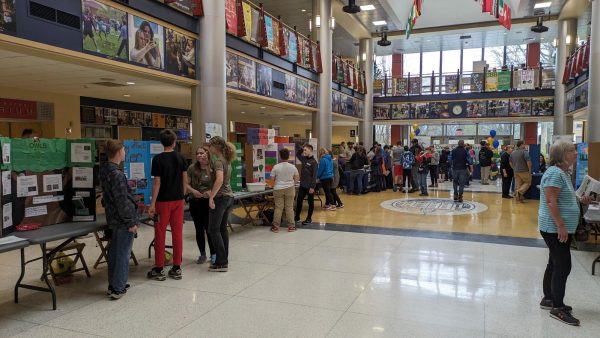Starry-eyed, star-focused: Astronomy club hosts Valentine’s event
Feb. 14 — the Allegheny College Astronomy Club hosted the star-crossed lovers event at 6 p.m in the Wible Planetarium in Carr Hall. This event taught people that astrology and astronomy are significantly different. Astrology is a pseudoscience that revolves around birthdays and positions of the stars and planets, while astronomy is a science that studies the stars, the planets,etc.
Co-President Grace Rohaley, ’20, has been part of the club for four years and has been co-president for one year. She joined the club to make new friends and try a new activity on campus.
“I have met long-term friends, and we talk about major news and astro events,” Rohaley said.
The star-crossed lovers event is “a way for people to make connections with people they have never met,” said Co-President Juliana Sebolt, ’20.
The Astronomy Club meets every Thursday from 5 to 6 p.m. on the third floor of the Henderson Campus Center, and it hosts multiple activities, such as homemade galaxy T-shirt making to celebrate the life of Galileo Galilei; a s’mores night when club members go up to the fields at Robertson Athletic Complex and look at stars through the telescope; a stargazing event; and a building the Saturn V out of legos event. The club also takes camping trips to Cherry Springs State Park to observe the stars.
Building the Saturn V would be an accomplishment to build out of legos because the Saturn V is the largest rocket sent to space.
Before the star-crossed lovers event, all the members received an email to sign up to be paired with someone they have a strong compatibility with in terms of astrological signs, by taking a test sent out by the Astronomy Club. Once members took the compatibility test, they were given their partner at the meeting on Feb. 4., and participants get to make new friends before the event starts to find out about similar interests and discover why the match was made.
“This event was about the signs of the zodiac and how horoscopes are hogwash (no predictive power), but nevertheless the signs people associate with horoscopes are actual constellations that the sun passes in front of over the course of the year,” said James Lombardi, professor of physics.
Sebolt said that Lombardi is the one that puts on the planetarium show for the event, which he said is always “fun and hilarious.”
“He tells jokes but he also teaches us a lot of things about astronomy and goofy things about astrology,” Sebolt said.
The projector effectively brings the stars and planets to life inside of the planetarium room. In the middle of the room, there is a miniature planet that comes up from the ground and the light hits the solar planet projector, and students can then see a digitized version of the stars.
At the event, attendees went into the planetarium room where the projector could display the stars on the dome. They practiced finding the constellations to get a virtual idea of the night sky. At the event, students learned the Acronym for the Zodiac Constellation which is “All The Great Constellations Live Very Long Since (Obviously) Stars Can’t Alter Physics.” The acronym is in the order of the Zodiac constellations which are Aries, Taurus, Gemini, Cancer, Leo, Virgo, Libra, Scorpio, Ophiuchus, Sagittarius, Capricorn, Aquarius and Pisces.
The signs follow the counter-clockwise order in which the planets move. At the meeting, attendees learned when the sign would be near the sun and how fast it moves. For instance, Pisces “wraps around half the Great Square of Pegasus, and the sun would hit Pegasus on April 1,” according to Lombardi.
Lombardi shared other facts with students at the event.
“Venus is nearly 1,000 degrees Fahrenheit, and it is the same size as the earth and about the same mass and only a little bit closer to the sun,” Lombardi said.
Astrology plays a huge part in astronomy by observing physics at work through the universe. Many of the club members are math or physics majors, but this club is open to anyone who is interested in the field. This event was held on Valentine’s Day because “it was a way to meet new people and make new friends outside of the physics and math department,” Rohaley said.






